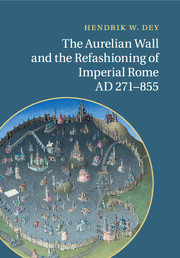Book contents
- Frontmatter
- Contents
- List of abbreviations
- List of figures
- Acknowledgements
- Introduction
- 1 Toward an architectural history of the Aurelian Wall, from its beginnings through the ninth century
- 2 Planning, building, rebuilding, and maintenance: the logistical dynamics of a (nearly) interminable project
- 3 Motives, meaning, and context: the Aurelian Wall and the late Roman state
- 4 The city, the suburbs, and the Wall: the rise of a topographical institution
- 5 Sacred geography, interrupted
- 6 The Wall and the “Republic of St. Peter”
- Conclusion
- Appendices
- Appendix A Numerical data
- Appendix B The fourth century revisited: the problem of Maxentius
- Appendix C The post-Honorian additions to the Porta Appia and other fifth- and sixth-century construction
- Appendix D The Aurelian Wall and the refashioning of the western tip of the Campus Martius
- Appendix E The Pons Agrippae and the Pons Aureli: a tale of two bridges
- Bibliography
- Index
Appendix D - The Aurelian Wall and the refashioning of the western tip of the Campus Martius
Published online by Cambridge University Press: 19 May 2011
- Frontmatter
- Contents
- List of abbreviations
- List of figures
- Acknowledgements
- Introduction
- 1 Toward an architectural history of the Aurelian Wall, from its beginnings through the ninth century
- 2 Planning, building, rebuilding, and maintenance: the logistical dynamics of a (nearly) interminable project
- 3 Motives, meaning, and context: the Aurelian Wall and the late Roman state
- 4 The city, the suburbs, and the Wall: the rise of a topographical institution
- 5 Sacred geography, interrupted
- 6 The Wall and the “Republic of St. Peter”
- Conclusion
- Appendices
- Appendix A Numerical data
- Appendix B The fourth century revisited: the problem of Maxentius
- Appendix C The post-Honorian additions to the Porta Appia and other fifth- and sixth-century construction
- Appendix D The Aurelian Wall and the refashioning of the western tip of the Campus Martius
- Appendix E The Pons Agrippae and the Pons Aureli: a tale of two bridges
- Bibliography
- Index
Summary
The building of the river wall and the destruction of the Pons Neronianus provide an interpretive key for the subsequent history of the western tip of the Campus Martius, from late antiquity to the present. The presence of the Wall clarifies and often reconciles many apparently diverse arguments made about the disputed topography of the region, and permits the reconstruction of a sequence of events that explains much about the dramatic topographical transformation of the area between the high empire and the early Middle Ages. I begin with a sequence of premises that seems to me to account best for the surviving topographical indicators and the often opposing positions taken by past scholars on a variety of points.
The river crossing at the site of the future Pons Neronianus, and the two primary axes of communication that converged on the riverbank in this spot, the “Via Recta” running east to west, and the Via Tecta from the south-east to north-west, all date well before the imperial period (Figure 4.1). A ferry at the vada Tarenti likely existed by the fourth century BC (Coarelli 1977, 842; 1997a, 77 and 130; cf. La Rocca 1984, 65–6). All previous arguments made to the effect that one or both roads did not reach the Pons Neronianus have them ending at the north–south road leading to the Pons Aelius, which led nowhere before the building of the bridge to the mausoleum, if it even existed.
- Type
- Chapter
- Information
- Publisher: Cambridge University PressPrint publication year: 2011



